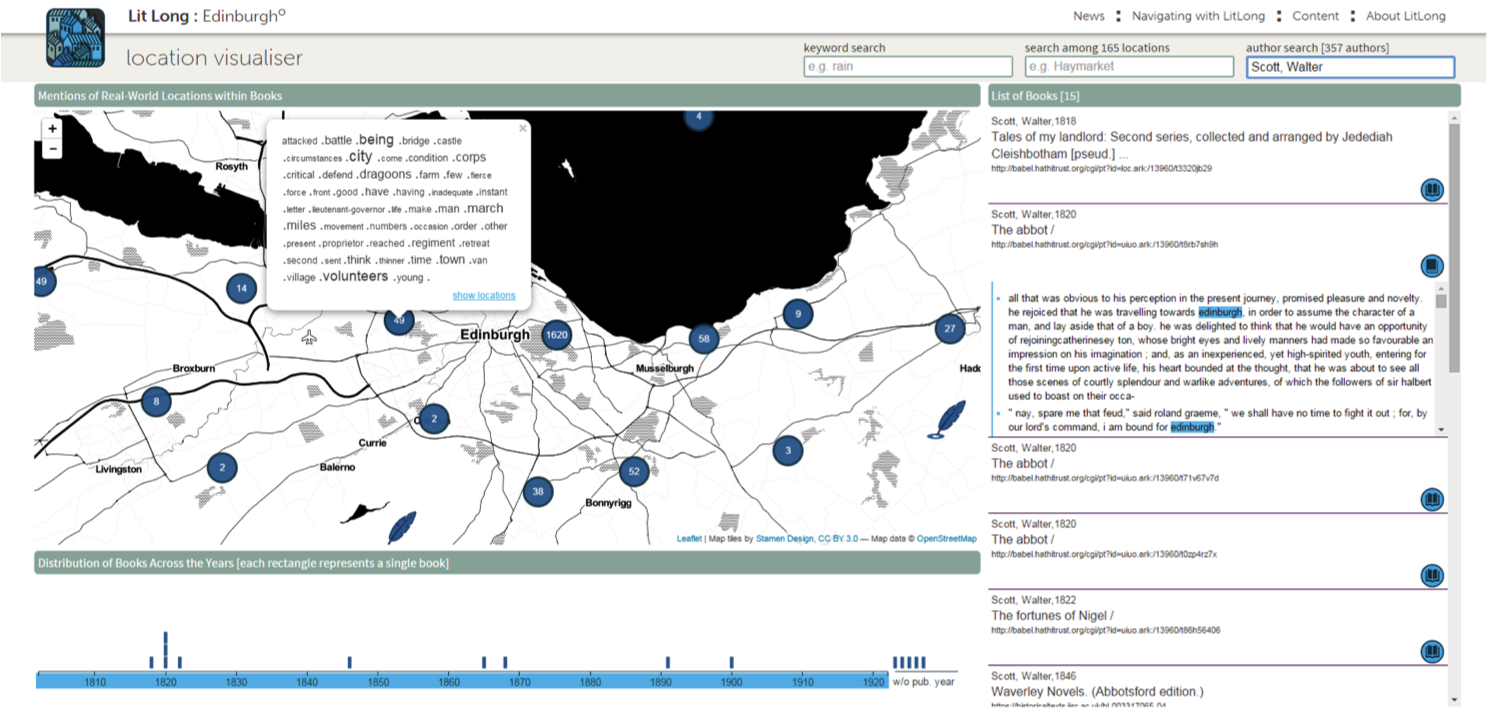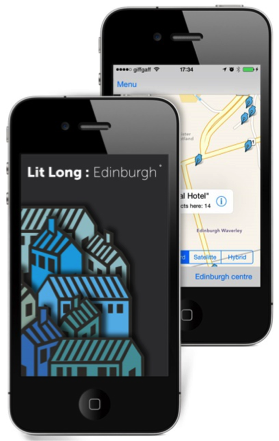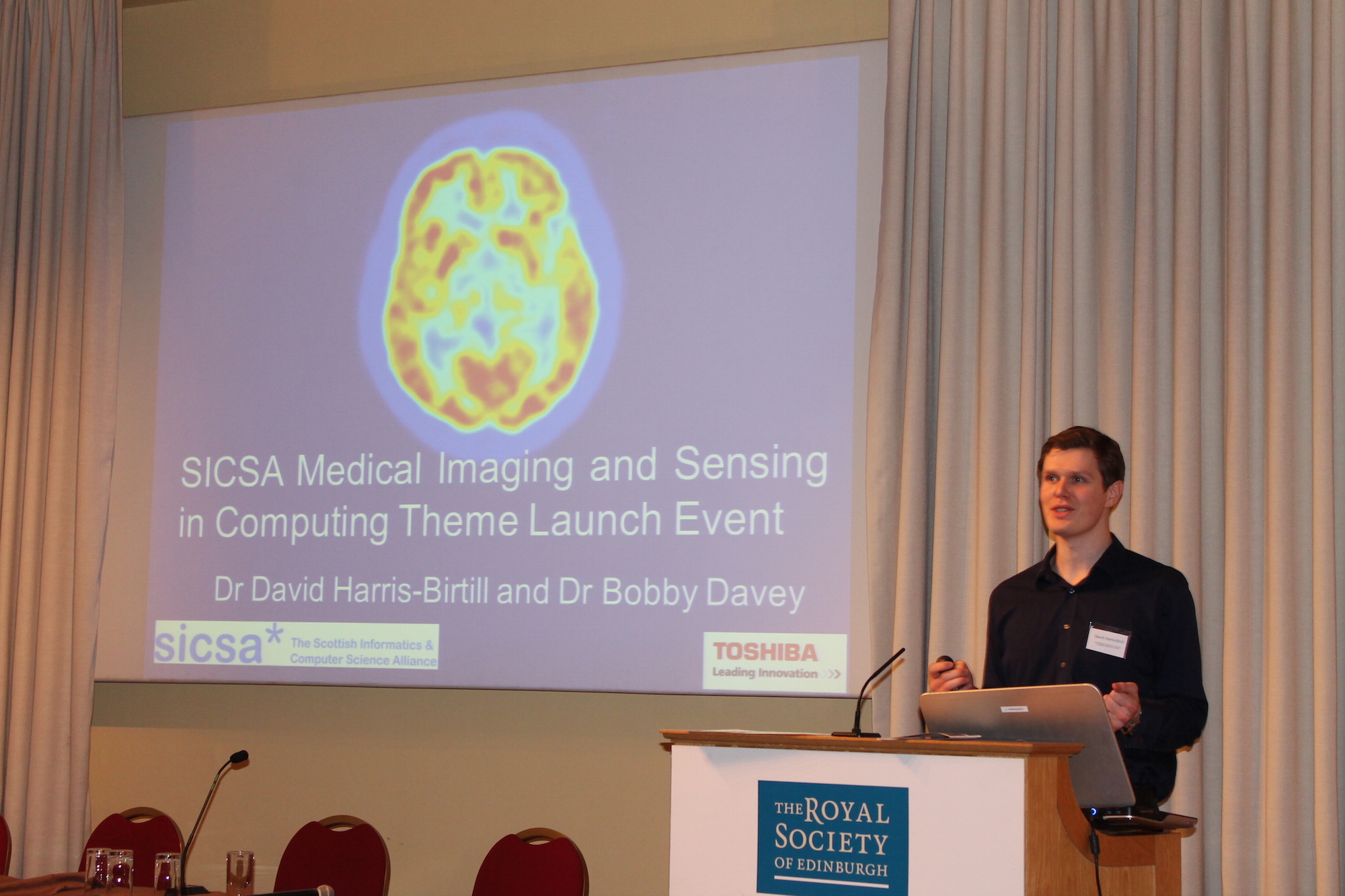The Palimpsest project involving the University of St Andrews’ SACHI team, collaborating with the University of Edinburgh’s English literature and text-mining group, has now completed its LitLong Edinburgh application and website, which are launched today (30th March 2015).


Lit Long: Edinburgh features a range of maps and accessible visualisations, which enable users to interact with Edinburgh’s literature in a variety of ways, exploring the spatial relations of the literary city at particular times in its history, in the works of particular authors, or across different eras, genres and writers. Lit Long: Edinburgh makes a major contribution to our knowledge of the Edinburgh literary cityscape, with potential to shape the experience and understanding of critics and editors, residents and visitors, readers and writers.
Give the web visualisation a try here.
SACHI’s Dr Uta Hinrichs created the web visualisation and Dr David Harris-Birtill created the mobile app. Professor Aaron Quigley was the University of St Andrews leader and co-investigator on the Palimpsest project.
This work is also featured on the Guardian’s website and mentioned in Edinburgh University’s news.
News
Three exciting events from the theme have already taken place: the theme launch at the Royal Society of Edinburgh, a Masterclass in Medical Imaging and Sensing at the University of St Andrews, and a Workshop on Medical Image Analysis at the University of Dundee.
Over fifty researchers from across Scotland from industry and academia came to speak, listen and network at the SICSA Medical Imaging and Sensing Theme Launch in the Royal Society of Edinburgh on the 18th February 2015, hosted by Toshiba Medical. Speakers included: Dr Diana Morgan (Censis), Dr Jano van Hemert (Optos), Dr Ian Poole (Toshiba Medical), Dr Tom MacGillivray (CRIC Edinburgh), Prof Stephen McKenna (University of Dundee), Dr Tom Kelsey (University of St Andrews), Prof Lynne Baillie (Glasgow Caledonian University), Dr Bobby Davey (Toshiba Medical) and Dr David Harris-Birtill (University of St Andrews).
At the SICSA Masterclass in Medical Imaging and Sensing, hosted by the University of St Andrews, thirty early career researchers came to learn more about how they can apply their skills in this exciting field on the 4th March 2015. Speakers included: Prof Manuel Trucco (University of Dundee), Dr Bobby Davey (Toshiba Medical), Dr David Harris-Birtill (University of St Andrews) and Dr Neil Clancy (Imperial College London).
The Workshop in Medical Image Analysis, held at the University of Dundee on the 27th March 2015 was a huge success with excellent oral and poster presentations. Over forty researchers came to hear the invited talks from Prof Giovanni Montana (Kings College London) and Prof David Wyper (SINAPSE) as well as the other excellent research talks.
We look forward to future events within the theme. If you are interested in hosting an event within the theme please email theme leader Dr David Harris-Birtill (dcchb@st-andrews.ac.uk) with a short proposal.
<!–Speaker: Nicolai Marquardt, University College London
Date/Time: 1-2pm April 13, 2015
Location: CS1.33a, University of St Andrews–>
Abstract:
Despite the ongoing proliferation of devices and form-factors such as tablets and electronic whiteboards, technology often hinders (rather than helps) informal small-group interactions. Whereas natural human conversation is fluid and dynamic, discussions that rely on digital content—slides, documents, clippings—often remain hindered due to the awkwardness of manipulating, sharing, and displaying information on and across multiple devices. Addressing these shortcomings, in this talk I present our research towards fluid, ad-hoc, minimally disruptive techniques for co-located collaboration by leveraging the proxemics of people as well as the proxemics of devices. In particular, I will demonstrate a number of cross-device interaction techniques—situated within the research theme of proxemic interactions—that support nuanced gradations of sharing. I will also introduce different novel hybrid sensing approaches enabling these interaction techniques and discuss future research directions.
Bio:
Nicolai Marquardt is Lecturer in Physical Computing at University College London. At the UCL Interaction Centre he is working in the research areas of ubiquitous computing, physical user interfaces, proxemic interactions, and interactive surfaces. He is co-author of the books Proxemic Interactions: From Theory to Practice (Morgan & Claypool 2015) and Sketching User Experiences: The Workbook (Elsevier, Morgan Kaufmann 2012).
This seminar is part of our ongoing series from researchers in HCI. See here for our current schedule.
In this talk academic staff members working on topics related to HCI will present an overview of their research and how this relates to the HCI MSc modules and program.
Prof. Aaron Quigley from the University of St Andrews is giving a talk on Friday 6th March. The talk will take place in Otaniemi in the TUAS building at 14:00.
TIME
Friday 6th March, 14:00-15:00
PLACE
TUAS
TITLE
Public-displays to the left of me, head-mounted displays to the right, Here I am, stuck with the mobile phone that is you!
ABSTRACT
Displays are all around us, on and around our body, fixed and mobile, bleeding into the very fabric of our day to day lives. Displays come in many forms such as smart watches, head-mounted displays or tablets and fixed, mobile, ambient and public displays. However, we know more about the displays connected to our devices than they know about us. Displays and the devices they are connected to are largely ignorant of the context in which they sit including knowing physiological, environmental and computational state. They don’t know about the physiological differences between people, the environments they are being used in, if they are being used by one or more people.
In this talk we review a number of aspects of displays in terms of how we can model, measure, predict and adapt how people can use displays in a myriad of settings. With modeling we seek to represent the physiological differences between people and use the models to adapt and personalize designs, user interfaces. With measurement and prediction we seek to employ various computer vision and depth sensing techniques to better understand how displays are used. And with adaptation we aim to explore subtle techniques and means to support diverging input and output fidelities of display devices. The talk draws on a number of studies from recent UMAP, IUI, AVI and CHI papers.
Our ubicomp user interface is complex and constantly changing, and affords us an ever changing computational and contextual edifice. As part of this, the display elements need to be better understood as an adaptive display ecosystem rather than simply pixels.
SHORT BIO
Professor Aaron Quigley is the Chair of Human Computer Interaction in the School of Computer Science at the University of St Andrews, UK. Aaron’s research interests include surface and multi-display computing, human computer interaction, pervasive and ubiquitous computing and information visualisation. He has published over 135 internationally peer-reviewed publications including edited volumes, journal papers, book chapters, conference and workshop papers and holds 3 patents. In addition he has served on over 80 program committees and has been involved in chairing roles of over 20 international conferences and workshops including UIST, ITS, CHI, Pervasive, UbiComp, Tabletop, LoCA, UM, I-HCI, BCS HCI and MobileHCI.


